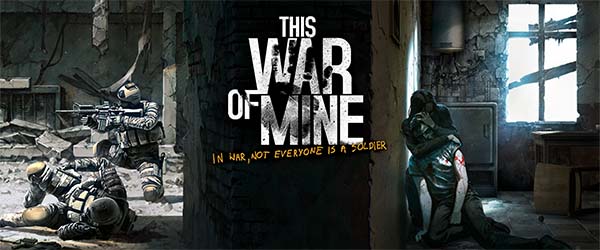
Games have an awkward relationship with war. Most games embrace violence and conflict because they are very easily simulated by computers and mapped to a set of easy-to-understand mechanics. Computers aren't as good at understanding or reacting to speech or emotion as they are at allowing a character to move around in a space and at tracing the path of a bullet or artillery shell. So when a game is about war, it's almost always told from the perspective of a soldier, someone actively participating in the war. And that character's participation is usually presented as noble and honorable, with the people that you are shooting being given little - if any - humanization at all. In many cases, the games will go out of their way to de-humanize the player's opponents by presenting them as literal demons, aliens, or the so-easy-to-hate Nazis.
While there are plenty of examples of games that deal with the behind-the-scenes causes and effects of a war, or the politics of conflict, these elements very rarely appear as central gameplay elements (outside of grand strategy games like Civilization, Total War, or Europa Universalis). Usually, the player plays on the battlefield, and any politics or effects beyond the battlefield are just material for non-playable cutscenes. At best, you might end up with a game that puts the player in the middle of the battle, but which has civilian characters that play a large role in the story.
One of my favorite games of the PS2-era is Ace Combat 4, which is a jet fighter combat game that found a comfortable middle-ground between flight sim and arcade shooter. Its narrative revolved around a child living in an occupied city, who befriends the ace fighter pilot of the occupying nation's air force. The player, however, takes on the role of a nameless, faceless ace fighter pilot belonging to the opposing liberation force. This created a fascinating dichotomy in which your success in missions resulted in defeats for the enemy ace who was the focus of the narrative. He falls into depression and alcoholism as the player systematically shoots down his wingmen and friends, and it served to humanize both sides of the conflict and exposed the human cost of war. One man's victory is the other's defeat. Your own victories became increasingly bittersweet as the game neared its final mission. It was a beautifully constructed scenario that has stuck with me to this day. I suspect that This War of Mine will leave a similar impact on me.
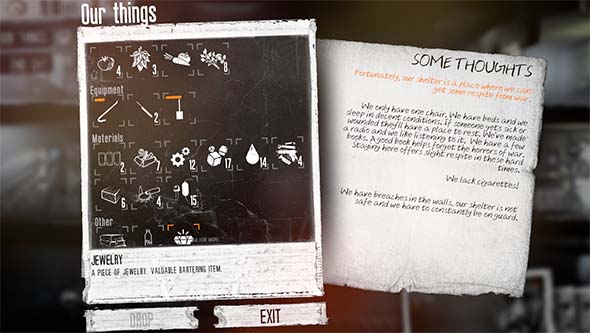
The logistics of keeping your shelves stocked with food and medicine is the primary challenge.
This War of Mine also reminds me of my visit to the Imperial War Museum in Manchester, U.K. this past January. I was really surprised by the difference in presentation that museum had as opposed to most museums that I visit in the United States. Whereas a museum in the U.S. will focus on exhibits of weapons, uniforms, vehicles, battle tactics, and politics behind wars, the IWM was focused primarily around the civilian costs of the two World Wars. It featured exhibits about food and material shortages, how women had to work as battlefield nurses and in factories, and how supplies were moved between cities under siege. It presented the wars as much more personal and ignoble and focused on how it affected people's day-to-day lives, and how the majority of people simply had to live through it. That's the same approach that the Polish studio behind This War of Mine took for their survival game.
Behind the lines
This War of Mine doesn't take place on the front lines or the battlefields. Instead of controlling a soldier, you play as a group of survivors in a rebellious city under siege. You have found a shelled building that you have claimed as a shelter, and every night, you must send one of your group out to scavenge one of various sites around the city for food, medicines, and other supplies to enable your group to [hopefully] survive till the end of the war. In the meantime, those who stay in the shelter must contend with the risk of being raided by other survivors during the night and having your hard-earned supplies stolen from under your own nose - or worse: somebody being hurt or killed.
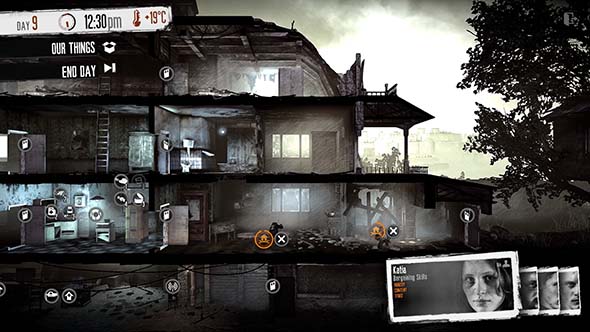
Your close-knit group of survivors must build and defend a shelter and scavenge for supplies.
The result is a game loaded to the brim with choices and consequences. How do your survivors spend their daytime hours? What items do you attempt to craft from your middling inventory of supplies? How do you defend yourself from raids? Do you send your one gun out with your scavenger in case he runs into hostile bandits, or keep it at home to defend your shelter from raids? Who do you send out each night to scavenge? Where do they go? And what do they bring back with them? The "rogue-like" fashion of the gameplay means that there's no undoing and no retries. This, combined with the scarcity of resources, makes every choice, every action, and every death is permanent. This gives a great deal of weight to all those choices that the game gives you.
... [More]
86d552ea-8fe5-4968-9a7d-1d98afbd4919|2|5.0
Tags:This War of Mine, PC, Steam, 11-bit studio, indie gaming, strategy, war, siege, refugee, civilian, survival, rogue
So, Chichian and I have both recently had issues with Steam that required us to create a support ticket. Steam has a rather obtuse system for support tickets, and for many users, it apparently doesn't work at all.
First and foremost, Steam's support requires that you make a separate account just for support. You don't log into Steam support using your existing Steam account. Supposedly, this is because the most common ticket is to retrieve access to a lost account. Either the player forgot their account info, or it had been hijacked. So in order to prevent people from having to make a whole separate Steam user account just to create a support ticket to retrieve their old Steam account, they set up this system in which support is its own separate account to begin with - for everybody. So even if you have full access to your Steam account and only want to report a bug in the client or have an issue with a purchased game not showing up in your library, you still have to go to the trouble of creating a completely separate account.
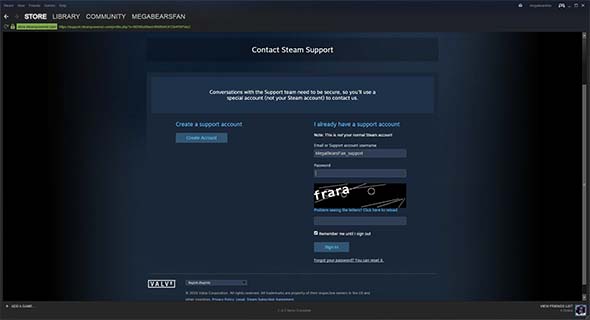
Steam Support requires a separate account from your normal Steam account.
You then have to go through the email validation process. After you create an account, they'll send you a verification email. Pretty common stuff. Unfortunately, many users (including myself and Chichian) never get these emails. The same might apply for email requests to reset a password if you forgot your support account's password. The email doesn't go into a spam folder. It doesn't go to the wrong account. It doesn't show up two days later because their emailer services are slow. The emails simply never show up. You're not crazy, there is an explanation.
Apparently, some email providers completely block Steam Support from sending emails to their users for ... some reason. I guess they think Steam Support is some kind of spammer or malware threat? Usually, you'd expect such an email to get sent to a spam folder. But not in this case. It's really annoying that providers are able to simply refuse traffic from specific sources, especially a source that is legitimate like Steam.

Use a gmail account for Steam Support.
It works ... for now ...
So bottom line: if you are having issues with creating or accessing a Steam Support account, you're not alone. If you're waiting for validation or password reset emails that simply never show up, it's probably because your provider is blocking them. Chichian's Steam Support emails were blocked by Hotmail and Yahoo. Mine was blocked by AOL. It appears that gmail does not block Steam Support though. We were both able to receive the emails when we created an account using gmail. So if you are having issues, I recommend using a gmail address to create your Steam Support account. It will save you some confusion and frustration. [More]
deb20a4c-f991-49d5-a0a9-c23f00a27913|2|5.0
Tags:Steam, Steam support, Valve, login, account, customer support, troubleshooting, email, yahoo, hotmail, AOL, gmail
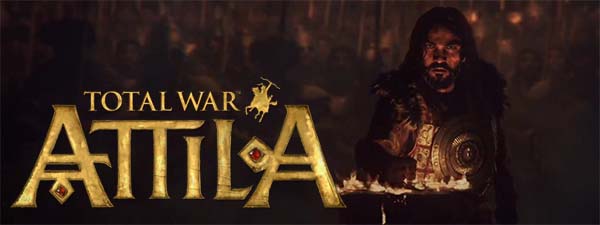
A few months ago, I posted an article outlining some suggestion for unique civilization themes and abilities for a possible Sid Meier's Civilization VI game. In it, I proposed a unique characteristic for the Huns or Mongolians: that they be a true nomadic empire. The idea was that they would have traveling cities that allowed them to move their empire with their army and essentially occupy any unclaimed territory or territory vacated by defeated rivals. Well, the Creative Assembly had already beaten me (and Firaxis) to the punch with Total War: Attila (and apparently Firaxis is embracing the idea with Beyond Earth's first expansion). Total War: Attila has a feature almost identical to what I had conceived for the Huns and Mongolians in Civilization. I'm a fan of the Total War series as is, so I was going to play this game for sure. Of course, Creative Assembly running with an idea that I had independently conceived of only made me more curious to play the game.
Attila acts as sort of a sequel to Rome II. While that game was all about building up the Roman empire (or whichever empire you happened to select), Attila is all about tearing down those empires. But this is a fully stand-alone game (like Napoleon Total War was to Empire Total War), and does not require Rome II in any way.
Learning how to be a horde
The Prologue campaign in this game is brutal! It's like a Demon's Souls tutorial that is designed to kick your ass. I restarted it once before realizing that it was designed for the player to fail in order to teach the new migration feature.
This prologue acts as a tutorial for the new features and mechanics of the game, but it doesn't do a particularly good job of teaching these mechanics. It also doesn't go into much detail of the established features of the franchise (other than telling you that a feature exists, then making you click on the button to do it), so new players might find themselves completely turned off by the fact that they are having their asses handed to them and aren't being taught much about how the game actually works, or - more importantly - why they are failing so hard. Perhaps having two separate tutorial campaigns would have been advisable: one to teach basic Total War concepts of empire and army management; and a second tutorial campaign for experienced Total War players that just teaches the migration features.
The brutal tutorial concludes with the challenging, climactic, historical battle of Adrianople,
in which your Visigoths must hold off Emperor Valens' superior army until your cavalry arrives.
Playing as migratory hordes minimizes city management, but you do still have to develop infrastructure for your nomadic armies. Rebuilding conquered cities and defending your borders, however, is not an issue - which was always the most tedious part of the game anyway. You don't need defensive armies in your territory and are free to focus all your efforts on your eventual goal. This change works well with the requirement that all armies must be attached to generals, and is a big step up from Rome II. There were large chunks of Rome II's campaign in which I felt like I couldn't do anything because I had to camp out my armies in cities in order to replenish and improve public order. Since I was at the army cap, the campaign would stagnate because I couldn't build new armies in order to watch over my newly-conquered settlements while also pressing forward with my primary armies... [More]
da530405-0213-4b1a-93c4-503924d797fd|0|.0
Tags:Total War, Total War: Attila, Creative Assembly, Sega, PC, Steam, Attila, Attila the Hun, Huns, Rome, Western Roman Empire, Eastern Roman Empire, Constantinople, Byzantine Empire, Sassanid Empire, Europe, Goths, Visigoths, Ostragoths, Germanic tribes, Franks, Saxons, Vandals, strategy, turn-based strategy, real-time strategy, grand strategy, history, campaign, horde, migration, climate change, the Great Migration, steppe, Sid Meier's Civilization, war, nomad, siege
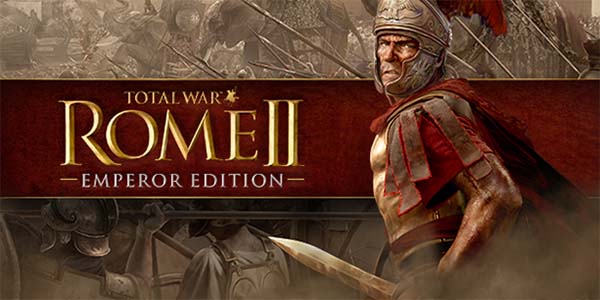
A couple years ago, I wrote an impressions post for Total War: Rome II with a tentative review score of 5 out of 10. I never got around to writing a full review of the game because it remained in a near constant state of flux for over a year after its release. The developers kept adding new DLC ranging from modest culture packs to the tiny Blood & Gore pack. Last year, Creative Assembly released a massive DLC pack that also included across-the-board balance updates and expansion of some of the game's core features. This "Emperor Edition", and its attached Imperator Augustus campaign was free to everyone who bought the original Rome II, and so I decided to give it a try to see if it greatly improved the game.
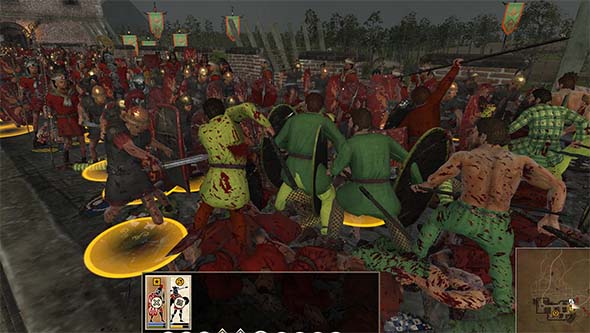
Blood & Gore costs a few dollars extra for those who want it, and increases the ESRB rating to Mature.
Core gameplay has subtle changes
Most of the changes to the core game are subtle, but they do add up to create a more enjoyable experience. The A.I. isn't nearly as bad as it originally was, and naval battles are actually playable now. Building effects have been completely rebalanced in order to avoid the problems with rampant squalor and lack of food that plagued the core game, and the politics systems have been changed to be more active and relevant to the game. Unfortunately, many of these changes are so sweeping, that they break existing campaign save games, meaning that if your version of Rome II was automatically updated, then you lost the ability to continue with any of your previous campaigns.
The most notable changes to empire management is that resources and building upgrades allow for much greater specialization of your various regions. This combined with the rebalancing of squalor and food means that there is incentive to actually upgrade your buildings past the first couple of levels. You also have some more meaningful decisions on what buildings you want to build and upgrade.
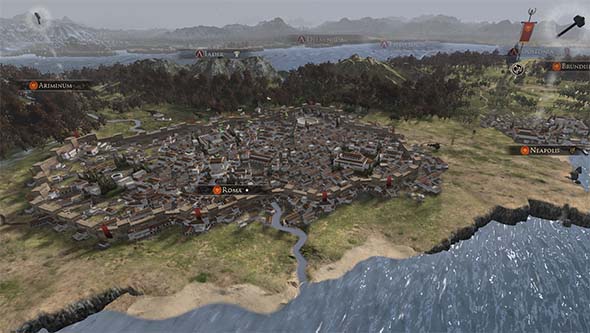
Squalor is no longer an intractable restriction towards building the glory of Rome.
Cities still physically grow on the map as the population grows and more buildings are constructed, and many of the high level buildings can add unique visual flairs to individual cities. It's also informative, since it's easy to see (at a glance) what infrastructure a city might have, which can help you manage your own empire, and can help you to assess the worth of a city for potential conquest.
A.I.s have also been designed to build higher-level settlements and to manage their armies better. Having higher-level buildings means that they have larger armies with more advanced units and better equipment. They provide a much greater challenge, as well as more tempting targets of conquest now. I haven't run into situations in which major factions (Carthage) dissolve into rebellions at the start of the game like I used to see in the base game.
Higher morale means battles last longer
Perhaps the best improvement that's been made by the post-release patches and the Emperor Edition is that the real-time battles are paced much better. Unit morale has been significantly tweaked so that units don't route and flee as soon as they make contact with a superior enemy force. Battles will generally take more than just a couple of minutes to complete, but they still aren't anywhere close to occupying the entire hour that the battle timer allows.
You'll actually have time to move some support units to help out an outnumbered defender before they flee, so there's also a lot more strategy involved in the individual battles. Reserve forces and cavalry flanking maneuvers have more relevance, and generals actually have time to reach front-line units in order to use their powers. You don't have to just clump all your units together in a single wall and ram them into your opponent anymore. You can even engage the enemy with a smaller force if you are stuck having to wait for reinforcements to arrive.
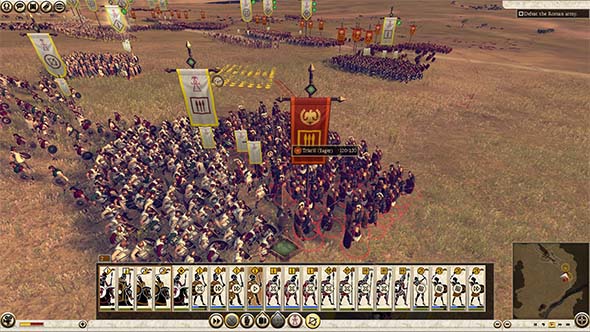
Tactical battles are slower, making cavalry and reserves more relevant, and allowing for more strategic thinking.
Speaking of cavalry, they are actually useful now, since units are generally more responsive to movement commands. In the initial launch version, I found cavalry to be useless because once they engaged an enemy unit, it was almost impossible to disengage without the whole unit getting routed or wiped out. Basically the only thing they were useful for was chasing down enemy skirmishers or flanking artillery. Now, I actually build and use cavalry because they are useful for hit-and-run attacks against regular melee infantry. You still want to keep them away from the pointy end of spears and pikes, but that's to be expected.
I still wish the battles were slowed down a little bit more, but the pacing is a lot better than it was at release. I still rarely see battles last more than 5 minutes of actual fighting, and I still routinely have to pause the game in order to issue orders because unit movement and combat happens so fast ... [More]
457b05a7-62ac-45d9-a1b0-5c8730e665e3|0|.0
Tags:Total War, Total War: Rome II, Rome: Total War, Creative Assembly, Sega, PC, Steam, Europe, Rome, Roman Empire, strategy, grand strategy, real-time stratey, turn-based strategy, history, campaign, war, siege
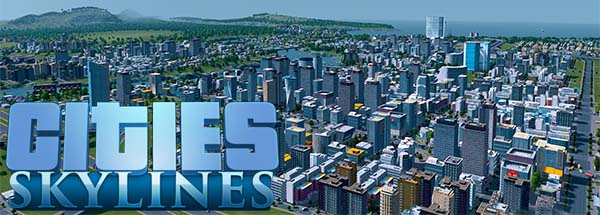
I've been on quite a city-builder bender this past eight months or so, and I've gone through quite a variety of games! From Tropico 5, to Cities XXL, Banished, and even a foray into the mobile game SimCity Buildit. Since the SimCity reboot in 2013 turned out to be a bust, I've been desperately searching for a modern game to fill the hole that was left after I moved on from SimCity 4. Cities XL held me over for a while, but my interest in it waned, and I was back to searching.
Well now that search can finally end, because I think I found my new, definitive city-builder: Cities: Skylines!
Almost immediately after starting a game, Skylines stands out as a very pretty game. The graphics have a very slight, cartoonish quality with very bright, vibrant colors. The animations are very smooth and fluid, which makes the map look very organic and alive. There's also some film grain and depth of field filters that can provide an immersive sense of being in the city when you zoom in. The depth of field effect only focuses on the center of the screen, which can look weird when you zoom very far in to look at certain objects. But if these effects become too bothersome, then you can always turn them off, and the game still looks great without them.
The various overlays are also very vibrant and have their own animations that show the flow of traffic along roads or water through pipes, and these overlays are also very pretty. The color contrasts also make them very easy to read and understand at a glance.
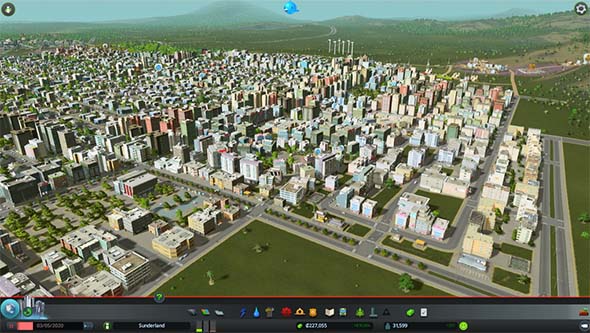
This game has very vibrant and attractive graphics and art styles that make the city look alive.
The game also has a very simple interface that looks good and is easy to read. Navigating through the menus is comfortable and intuitive, and it doesn't take up very much screen space.
Much like Cities XL, Skylines also gradually unlocks new buildings, infrastructure, and services as the city grows. Again, as somebody who routinely ran my SimCity 2000 cities into bankruptcy by overbuilding services and utility infrastructures early, I appreciate how this feature creates a gentler learning curve and helps to tutorialize new players in how the new features work.
Skylines differentiates itself from Cities XL and SimCity by providing a much more comfortable compromise of pacing and scale... [More]
b004b9b6-ce66-4953-8dd0-cc1289e3a97a|2|5.0
Tags:Cities: Skylines, Colossal Order Ltd., Paradox Interactive, Steam, Steam Workshop, city simulation, resources, roads, traffic, utilities, water pipes, power lines, garbage collection, cemetery, asset editor, policies
|

| 12 | | | | | | | 60 | | 11 | | | | | | | 55 | | 10 | | | | | | | 50 | | 09 | | | | | | | 45 | | 08 | | | | | | | 40 | | 07 | | | | | | | 35 | | 06 | | | | | | | 30 | | 05 | | | | | | | 25 | | 04 | | | | | | | 20 | | 03 | | | | | | | 15 | | 02 | | | | | | | 10 | | 01 | | | | | | | 05 |
|